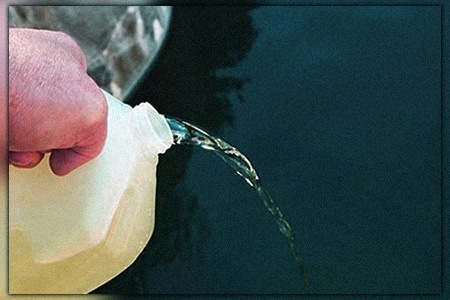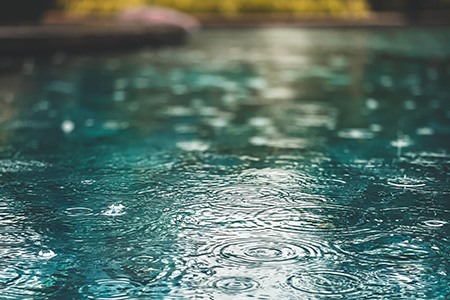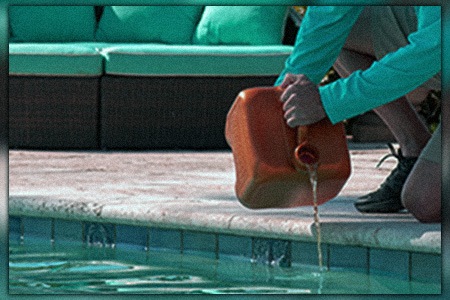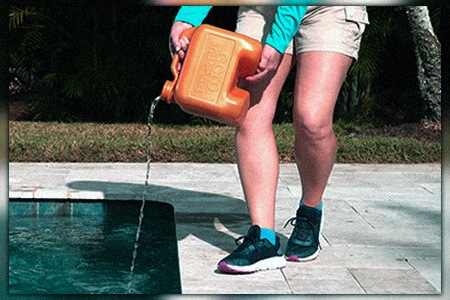How Much Liquid Chlorine to Add to a Pool?
Author: Chris Miller | Editor: Omar Alonso
Review & Research: Jen Worst & Chris Miller

Maintaining a sparkling pool is no easy task, and one crucial aspect of proper upkeep is knowing how much liquid chlorine to use. The right balance ensures your swimming pool remains clean and safe from harmful algae and other substances. How much liquid chlorine to add to a pool depends on a few factors.
Dive into this comprehensive guide for understanding the importance of liquid chlorine, factors affecting its dosage, calculating the perfect amount for your pool, safely administering it, and expert tips on maintaining ideal pool chemistry.
Understanding Liquid Chlorine For Pool Maintenance
You just filled your pool with water, now what? It's time to deal with chlorine. Liquid chlorine is a powerful and effective tool for maintaining the health of your pool, as it works by killing harmful bacteria and neutralizing other contaminants that may be present in the water.
How Liquid Chlorine Works

Liquid chlorine introduces a powerful disinfecting agent, sodium hypochlorite, into your swimming pool. This chemical compound breaks down organics and bacteria in the water through oxidation.
As sodium hypochlorite dissolves, it releases free available chlorine (FAC) as hypochlorous acid (HOCl).
Hypochlorous acid is highly effective at eliminating harmful contaminants such as algae and pathogens that can cause illness when ingested or come into contact with skin.
Additionally, liquid chlorine helps to keep pool water clear and clean by eliminating organic waste materials like sweat, oils from sunscreens, leaves, and dirt particles—all of which can accumulate over time and lead to cloudiness or unpleasant odors.
Benefits of Using Liquid Chlorine for Pool Maintenance
Liquid chlorine has become a popular choice among pool owners due to its numerous advantages over other forms of pool sanitizers. One significant benefit is its cost-effectiveness compared to granular shock, making it an appealing option for those seeking to maintain their swimming pool on a budget.
Another notable advantage of using liquid chlorine for your pool maintenance routine is its ability to promptly raise and maintain ideal chlorine levels without excessively increasing stabilizer levels like some traditional stabilized-chlorine tablets—a critical factor in maintaining proper water balance and preventing problems such as algae growth.
Furthermore, liquid chlorine effectively supports overall water sanitation by eliminating contaminants that may cause potential health risks or unpleasant odors.
The Importance of Regular Chlorine Maintenance for Pool Health & Safety
Regular chlorine maintenance is crucial for maintaining the health and safety of your swimming pool. An essential component of proper pool sanitation, chlorine works tirelessly to eliminate harmful bacteria, algae, and other microorganisms that may pose significant risks to swimmers.
Inadequate or inconsistent chlorine maintenance can lead to many problems, such as murky water, foul odors, skin irritations, and various water-borne infections. Moreover, unchecked algae growth can increase the risk of accidents due to slippery surfaces.
How Much Liquid Chlorine to Add to a Pool
There are different factors to consider during this process, such as the pool size and water volume, current chlorine levels, and weather conditions.
Pool Size & Water Volume

The size of your pool is the most crucial factor when determining the amount of liquid chlorine to add. The larger your pool, the more liquid chlorine you need to maintain proper water balance.
To calculate how much liquid chlorine you require for a specific volume of water, it's essential to know your pool's total water capacity.
When determining the right dosage for your pool, it is also important to consider factors such as sunlight exposure and average temperatures. For example, suppose you live in an area with high temperatures and scorching sun rays that continually evaporate your pool water. In that case, you may need to add more liquid chlorine than someone who lives in a cooler climate with less sun exposure.
Current Chlorine Levels
Maintaining the proper amount of chlorine in your pool is crucial for ensuring that it remains sanitary and safe for swimming. When determining how much liquid chlorine to add to your pool, one critical factor is the current chlorine levels.
Algae and bacterial growth can occur if the levels are too low, harming swimmers.
The ideal chlorine balance in a pool is between 1 and 3 ppm (parts per million), with one ppm being the minimum recommended level to keep bacteria at bay. You can test your pool's current chlorine levels using a water testing kit or strips available at most pool supply stores or online retailers.
Weather Conditions

Weather conditions, such as sun exposure and rainfall intensity, can affect the amount of liquid chlorine that needs to be added to your pool. High levels of UV radiation can cause the chlorine in the water to break down more quickly, requiring more frequent additions of liquid chlorine.
Heavy rain can also dilute the chlorine in your pool, making it less effective at keeping your water clean. Additionally, warmer weather and increased pool use by swimmers will require you to add more chlorine regularly to maintain proper levels of water sanitation.
Type of Pool & Pool Usage
The type of pool you have and how you use it can greatly impact the amount of liquid chlorine needed for maintenance. For instance, an indoor pool that is covered most of the time will require less chlorine than an outdoor pool exposed to sunlight.
Similarly, a heavily-used pool with a greater number of swimmers will need more regular chlorine dosages than a lightly-used one. Factors such as filtration systems, water quality, and pH balance should also be considered when determining chemical treatment needs.
Liquid Chlorine Calculations & Recommended Levels

So, how much liquid chlorine to add to a pool? To determine the right amount of liquid chlorine to add to your pool, you must consider factors such as pool size, current chlorine levels, weather conditions, and type of pool usage.
Formula for Calculating Liquid Chlorine Dosage
To determine the amount of liquid chlorine to add to your pool, you'll need to calculate the correct dosage. The formula for breakpoint chlorination using liquid chlorine (sodium hypochlorite) is the volume of the pool in gallons times 8.3 (weight of one cubic ft of water), times the combined chlorine level (CC level, found using a DPD test) times 10 divided by one million. Yes, it's wild.
Consequently, this will give you the total ounces of liquid chlorine required to reach breakpoint chlorination when enough chlorine has been added to break down contaminants and restore proper sanitation levels.
So an example would be for how much chlorine far a 1000 gallon pool. The calculation is 1000 times 8.3 times an example 0.8 CC level times 10 divided by one million. This equals 0.0664 gallons of chlorine to add to a 1000 gallon pool (assuming a measured 0.8 CC level).
Recommended Chlorine Levels for Pools
Ensuring that your pool has the right chlorine balance is critical for maintaining water quality and for preventing any side effects. The basic balance of chlorine to water in a pool should be between 1 and 3 parts per million (ppm), with a free chlorine concentration recommended by the CDC of at least one ppm for pools and at least three ppm for hot tubs/spas.
A quick way to determine if you have enough chlorine in your pool is to use test strips or kits, which can indicate whether the levels are too low, too high, or just right. At this point it's not about how many gallons of chlorine to add to a pool, but a continual adjustment to stay in the 1 to 3 ppm range.
Safe Chlorine Dosage & Common Mistakes To Avoid
When adding chlorine to your pool, it is important to ensure that you use the correct amount and take appropriate safety precautions. Overusing chlorine or not handling it properly can result in skin irritation, eye damage, and even respiratory problems.
One common mistake many people make is adding shock directly into the pool. Shock contains a concentrated form of chlorine which can cause an uneven distribution in the water if it is added incorrectly.
The best way to add shock treatment is by first dissolving it in a bucket filled with cool water before pouring the solution around the outside pool where there is good circulation. Additionally, wear gloves when handling any liquid or chemical used for pool maintenance. Then wait the appropriate amount of time to swim after shocking your pool.
Steps to Safely Add Liquid Chlorine to Your Pool

Adding liquid chlorine to your pool can be simple if you follow the proper steps. First, it's essential to test your pool's current chemical levels using a testing kit.
Then, calculate the amount of liquid chlorine needed to raise it to the recommended level based on the formula for calculating liquid chlorine dosage.
You must also wear protective gear like gloves and goggles when handling chemicals like liquid chlorine. Finally, ensure proper circulation by running your pump after adding any substances to help distribute them evenly throughout your pool water.
Maintaining balanced pH levels and regular disinfection with chlorination is vital for keeping pools clean and healthy for swimming.
Liquid Chlorine Usage FAQs
Here are some FAQs for how much chlorine to add to a pool per gallon.
How Much Chlorine Should I Put in My Swimming Pool?
Typically, the ideal chlorine level for saltwater and chlorine pools is between 1 and 3 parts per million (ppm). This can vary depending on the type of pool, its size, and how often it's used.
How Do I Determine How Much Chlorine My Pool Needs?
The amount of chlorine your pool needs depends on the pool's size and how often it's used. You'll need to test the water regularly using a pool testing kit to ensure it stays within the ideal range of 1-3 ppm.
Can I Add Too Much Chlorine to My Swimming Pool?
Yes, having too much chlorine in your pool can be harmful. It can cause skin, eye, and lung irritation. It can also damage your pool equipment and the pool lining.
That’s How Much Liquid Chlorine to Add to a Pool
In conclusion, maintaining the correct chlorine levels in your swimming pool is crucial for the health and safety of those using it. Remember that it's always better to err on the side of caution and consult a pool maintenance professional when in doubt. We hope our guide answered all your queries regarding how much liquid chlorine to add to a pool. Happy swimming!



